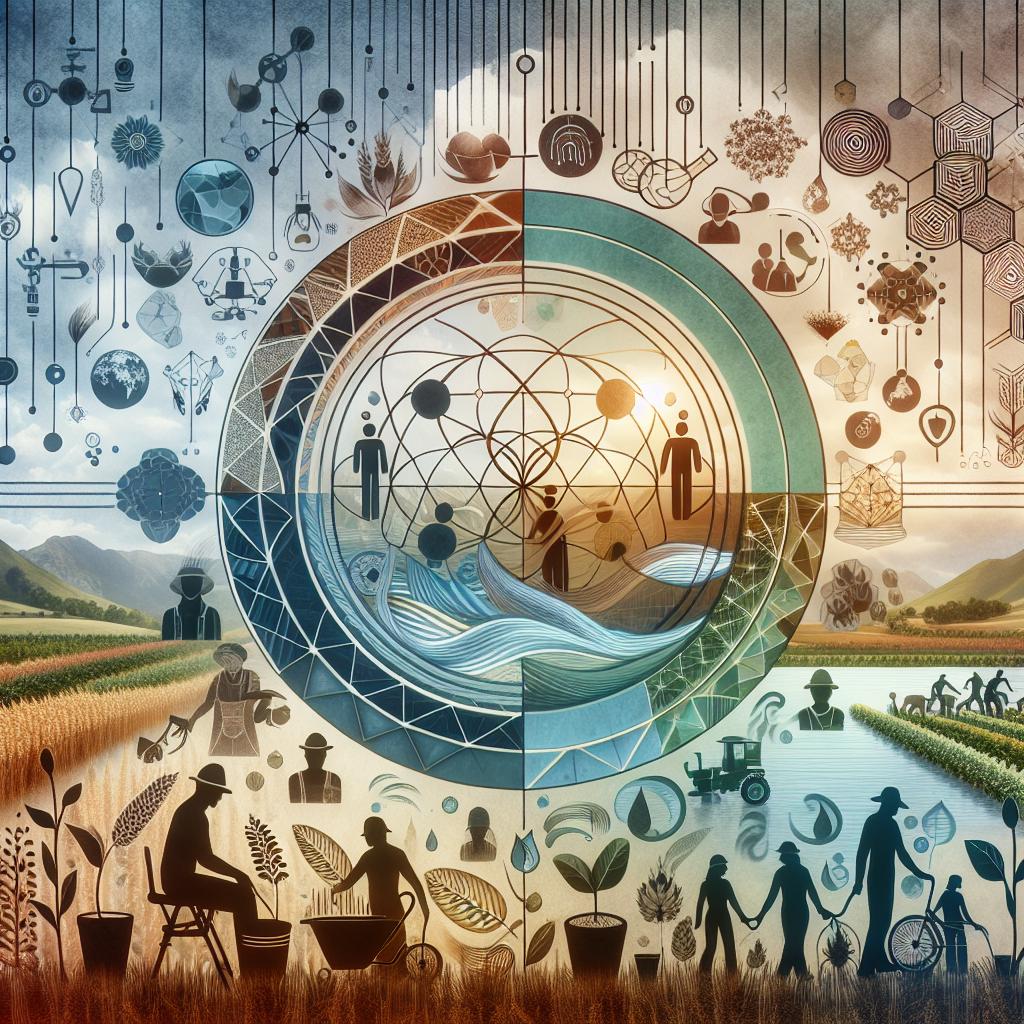This post may contain affiliate links which means I may receive a commission for purchases made through links. Learn more on my Private Policy page.
Introduction:
Picture a lush, thriving farm, where vibrant crops sway gently in the breeze under the golden sun. This idyllic scene isn’t just a product of nature’s whim; it’s often cultivated through the artful dance of irrigation. As the world grapples with changing climates adn the persistent challenge of water scarcity, the role of irrigation in water resource management has never been more crucial. From intricate systems that efficiently distribute precious water to innovative techniques that conserve resources, irrigation isn’t just about nurturing our fields—itS about safeguarding our planet’s most vital resource. In this article, we’ll explore how responsible irrigation practices can transform farming, foster sustainability, and create a harmonious balance between agriculture and nature. So grab your watering can and let’s dig into the fascinating world of irrigation and its vital role in the stewardship of our cherished water resources!
The Art of balancing Act: How Efficient Irrigation Transforms Water Use on Farms
Efficient irrigation practices hold the key to transforming water use on farms, ensuring that crops recieve the moisture they need without wasting precious resources. By implementing modern systems like drip irrigation and smart controllers, farmers can achieve a remarkable balance between crop demands and available water supplies.This not only enhances plant growth and yields but also contributes to the sustainability of water resources. Here are some innovative techniques farmers adopt to elevate their irrigation game:
- Drip Irrigation: Delivers water directly to the plant roots, minimizing evaporation and runoff.
- Soil Moisture Sensors: Provide real-time data to optimize irrigation schedules based on actual plant needs.
- Rainwater Harvesting: Collects and utilizes rain, reducing dependency on ground or surface water sources.
The transition to efficient irrigation systems not only conserves water but also fosters a deeper understanding of water resource management among farmers. When equipped with data-driven insights from technologies such as satellite imaging and weather forecasting, farmers can make informed decisions that promote sustainability. Here’s a comparison of irrigation methods based on water efficiency:
| Irrigation Method | Water Efficiency (%) |
|---|---|
| Drip Irrigation | 90-95% |
| Sprinkler Irrigation | 70-80% |
| Surface irrigation | 60-70% |
By striking the perfect balance between water submission and crop needs, farmers can become stewards of their land, playing a crucial role in preserving water resources for future generations. The art of efficient irrigation continues to evolve, empowering agricultural practices that address the challenges of today’s changing climate.

Cultivating Sustainability: Innovative Irrigation Techniques for a Greener Future
Innovative irrigation techniques are revolutionizing the way farms manage water resources, leading to both environmental benefits and enhanced productivity. by employing methods such as drip irrigation and smart irrigation systems, farmers can precisely control water application, ensuring that each plant receives the optimal amount without wastage. These technologies not only conserve water but also improve soil health by minimizing runoff and erosion, allowing for a more sustainable farming approach. The shift from traditional methods to these cutting-edge systems represents a critical step toward achieving a balance between agricultural needs and environmental protection.
Moreover, the integration of rainwater harvesting and soil moisture sensors provides farmers with tools to monitor and manage their water resources efficiently. Rainwater harvesting systems allow farms to capture and store precipitation for use during dry spells, reducing dependence on external water sources. soil moisture sensors help farmers make data-driven decisions about irrigation schedules, further optimizing water usage. By adopting these sustainable practices, farms can contribute to the broader goal of water conservation, reinforcing the principle that every drop counts in a world where water scarcity is becoming an increasing concern.

from Drought to Abundance: Harnessing Technology to Optimize Water Resources
In the quest to transform arid landscapes into flourishing farms, technology emerges as a key player in redefining how we approach irrigation. By leveraging innovative systems such as drip irrigation and smart sensors, farmers can now deliver the right amount of water directly to the roots of crops. This targeted approach not only conserves water but also enhances crop yields, allowing for a sustainable balance within the ecosystem. The integration of data analytics enables farmers to assess moisture levels,predict weather patterns,and optimize their irrigation schedules,ensuring that every drop counts. Consequently, farms can thrive even in challenging conditions that previously hindered agricultural productivity.
Moreover, the evolution of mobile applications and internet-connected devices empowers farmers with real-time insights into their water usage and crop health. Through automated irrigation systems, they can set parameters that match specific crop requirements, thereby reducing waste and increasing efficiency. Consider the following benefits of modern irrigation technology:
- Water Conservation: Significant reduction in water use compared to traditional methods.
- Increased Efficiency: Maximizes resource use by delivering water directly to plants.
- Precision Agriculture: seamless integration with soil and climate data for tailored farming solutions.
| Technology | Advantages |
|---|---|
| Drip Irrigation | minimizes evaporation and runoff, targeting root zones |
| Smart Sensors | Provides real-time data on soil moisture levels |
| Automated Systems | enables precise timing and volume of irrigation |

Building Community resilience: Collaborative Water Management Strategies for Local Farmers
effective irrigation practices are crucial for enhancing water resource management on farms, particularly in regions facing water scarcity. By employing collaborative strategies, local farmers can optimize water use while ensuring that crops receive the necessary hydration to thrive. Some innovative irrigation techniques that promote community resilience include:
- Drip Irrigation: This method minimizes evaporation and ensures targeted watering, leading to reduced water waste and increased crop yield.
- Rainwater harvesting: Capturing and storing rainwater not only supplements irrigation needs but also mitigates the impact of floods.
- Soil Moisture Sensors: These tools provide real-time data to farmers, enabling them to adjust irrigation schedules based on actual soil moisture levels.
Moreover, establishing a cooperative model for resource sharing can amplify the benefits of these practices. When farmers collaborate on water management, they can collectively negotiate better access to water resources and share the costs of advanced irrigation technologies. Below is a simple table that illustrates potential advantages of a cooperative approach:
| Collaboration Benefits | Description |
|---|---|
| Cost Sharing | Pooling resources for equipment reduces individual financial burdens. |
| Knowledge exchange | Farmers can share best practices and techniques for efficient water use. |
| Emergency Support | A united approach allows for joint efforts in crisis situations, strengthening resilience. |
Concluding Remarks
As we conclude our exploration of the vital role irrigation plays in water resource management on farms, it’s clear that these systems are more than just a method of supplying crops with the moisture they need to thrive. They represent a harmonious blend of innovation, sustainability, and resilience in the face of an ever-changing climate. By adopting efficient irrigation practices, farmers not only enhance their own productivity but contribute to the health of our ecosystems and the future of food security.
So, whether you’re a seasoned farmer, an aspiring green thumb, or simply someone who enjoys the fruits of agricultural labor, remember that every droplet counts. Embracing effective irrigation techniques is a step towards nurturing our land and preserving water for generations to come.
As we dig deeper into our understanding of water resource management, let’s carry this knowledge with us, cultivating a future where every farm flourishes, every crop thrives, and our precious water resources are used wisely. Happy farming, and may your fields be ever hydrated!
This post may contain affiliate links which means I may receive a commission for purchases made through links. Learn more on my Private Policy page.
